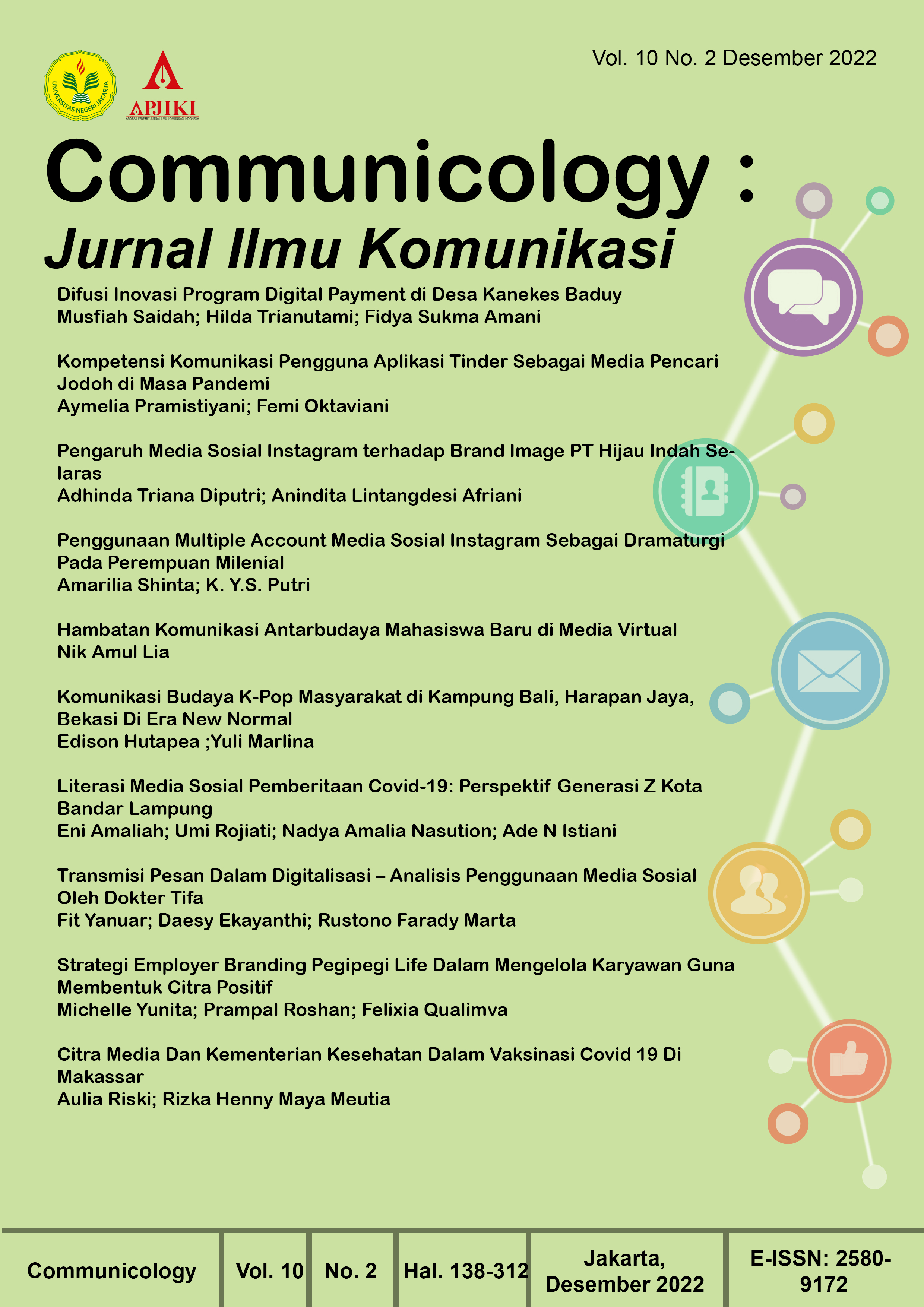Transmisi Pesan Dalam Digitalisasi – Analisis Penggunaan Media Sosial Oleh Dokter Tifa
DOI:
https://doi.org/10.21009/COMMUNICOLOGY.030.08Keywords:
Media Sosial, Teori Transmisi Pesan, Analisis Wacana, Penurunan CitraAbstract
Doctor Tifa is of a social media activist with such high credibility to the point her posts were used by other mass media as a source of information. There was a shocking post regarding Jokowi’s “fake certificates” on October 2022. These posts were the last time Doctor Tifa received her most news exposure and was seen on social media. The research is aimed to identify how Doctor Tifa constructs the “fake certificate” message to the audience and creates a digital phenomenon. The qualitative study uses the Message Transmission Theory by Shannon and Weaver and uses a text analysis of Doctor Tifa’s latest posts on social media. The research data displayed that Doctor Tifa purposefully attempted to defame President Jokowi by constructing “fake certificates” messages on social media. Digital messages are capable of being distributed quickly and widely, which gives birth to a new phenomenon in the digital world.
Keywords: Social Media; Message Transmission Theory; Content Analysis; Defamation
ABSTRAKDokter Tifa memiliki salah satu akun media sosial dengan kredibilitas tinggi sehingga banyak media massa menggunakan unggahannya sebagai sumber informasi. Salah satu unggahan Dokter Tifa tentang “ijazah palsu” Jokowi mengguncangkan media massa pada bulan Oktober 2022. Kumpulan unggahan tersebut menjadi kali terakhir Dokter Tifa mendapatkan perhatian media terbanyak dan juga kali terakhir beliau terlihat dalam media sosial. Penelitian ini ditujukan untuk menginterpretasi konstruksi pesan “sertifikat palsu” oleh Dokter Tifa di media sosial. Penelitian kualitatif ini menggunakan Teori Transmisi Pesan oleh Shannon dan Weaver dengan analisis wacana sebagai metode penelitian untuk mengkaji unggahan Dokter Tifa dalam media sosial. Hasil penelitian menunjukkan bahwa Dokter Tifa dengan sengaja berusaha untuk merusak citra Presiden Jokowi dengan merancang pesan “ijazah palsu” dalam media sosial. Pesan digital dapat terdistribusi secara luas dalam waktu yang singkat, sehingga unggahan tersebut mampu melahirkan sebuah fenomena dalam dunia maya.
References
H. Hindersah et al., “Prototype Development of Single Phase Prepaid,” International Conference on Electrical Engineering and Informatics, Bandung: Institute of Electrical and Electronics Engineers, pp. 1-6, 2011.
I. D. Syahwir et al., “Internet Of Things Of Electronic Seal Base On Gprs Short Message Service And Thingspeak Spektra,” Jurnal Fisika Dan Aplikasinya, vol. 4, no. 3, pp. 125-132, 2019.
A. Imran and M. Rasul, “Pengembangan Tempat Sampah Pintar Menggunakan Esp32,” Jurnal Media Elektrik, vol. 17, no. 2, pp. 2721-9100, 2020.
Kho Dickson, “Pengertian transistor dan Jenis-jenis Transistor,” Undang-Undang Republik Indonesia No. 2 Tahun 1981, Metrologi Legal Jakarta : Author, 1981.
L. Lancor and S. Katha, “Analyzing PHP frameworks for use in a project-based software engineering course,” 44th ACM technical symposium on Computer science education (SIGCSE ’13), New York: Association for Computing Machinery, pp. 1-6, 2013.
Menteri Perdagangan, “Peraturan Menteri Perdagangan Republik Indonesia Nomor 26/M DAG/PER/5/2017, Tentang Pengawasan Metrologi Legal,” Jakarta, Indonesia, 2018.
K. Maurya, M. Singh and N. Jain, “Real Time Vehicle Tracking System using GSM and GPS Technology-An Anti-theft Tracking System,” International Journal of Electronics and Computer Science Engineering, vol. 2, no. 3, pp. 1103-1107, 2012.
M. S. Novendri, A. Saputra and C. E. Firman, “Aplikasi Inventaris Barang Pada MTS Nurul Islam Dumai Menggunakan PHP Dan MySQL,” Lentera Dumai, vol. 10, no. 2, pp. 46-57, 2019.
N. Nurseitov et al., “Comparison of JSON and XML Data Interchange Formats: A Case Study,” Bozeman, Montana, United States of America, 2009.
C. Platt, “Encyclopedia of Electronic Components,” Power Sources & Conversion, San Fransisco: O’Reilly Media, vol. 1, 2012.
C. Platt and F. Jansson, “Encyclopedia of Electronic Components,” Signal Processing, San Fransisco: Maker Media, vol. 2, 2014.
C. Platt and F. Jansson, “Encyclopedia of Electronic Components,” Sensors for Location, San Fransisco: Maker Media, vol. 3, 2016.
Downloads
Published
How to Cite
Issue
Section
License
Authors who publish with this Journal agree to the following terms:
- Author retain copyright and grant the journal right of first publication with the work simultaneously licensed under a creative commons attribution licensethat allow others to share the work within an acknowledgement of the work’s authorship and initial publication of this journal.
- Authors are able to enter into separate, additional contractual arrangementfor the non-exclusive distribution of the journal’s published version of the work (e.g. acknowledgement of its initial publication in this journal).
- Authors are permitted and encouraged to post their work online(e.g. in institutional repositories or on their websites) prior to and during the submission process, as it can lead to productive exchanges, as well as earlier and greater citation of published works.
Users/public use of this website will be licensed to CC BY





